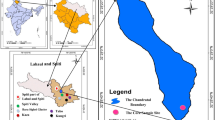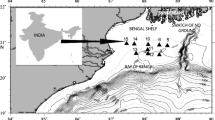Abstract
Wetland sediments are considered as prominent documents for studying climate change and sedimentary environments globally. Environmental changes (whether in climate, terrain, or in both) affect the process of sedimentation. The sediment changes are also reflected in the physical and chemical properties of sediments through which the process and the environment of sedimentation in the ancient times can be tracked. There are several methods for identifying climatic conditions in the past, such as isotopic studies, vegetation identification, sedimentology, and geochemistry of elements. In this research, after the registration of the sediments, to reconstruct the past climatic conditions of the Hoor-Al-Azim wetland, the changes in manganese, calcium, iron, and aluminum elements along with three sedimentary cores at three stations were studied, and age determination with carbon-14 isotope in Core 3 was applied to determine the sedimentation rate. The depth of the cores taken was 50 cm and the number of specimens in each core was 11; a total of 132 samples were sent to the steel company of Khuzestan, so that the concentration of metals could be measured by ICP-OES. To determine the age of the 15, 30, and 45 cm depths taken from the southernmost core, sediment samples were sent to the Poznan Radiocarbon Laboratory in Poland. The average sedimentation rate in Hoor-Al-Azim wetland is around 0.3 mm per year and the core covers about 1500 years. As calcium, manganese, iron, and aluminum are the important indicators for determining the chronic climatic conditions and are sensitive to the climatic changes, and due to the anomalies of these elements along the cores, about 700 years ago, with decreasing calcium and elevated iron, alumina and manganese elements are the wet climates that have led to the introduction of continental cessation deposits into the basin. After this period, the increase in calcium levels, which indicates an increase in sediment in the basin is considered as the beginning period of dry climate in the region. Of course, the effects of the changes of Karkheh River and the impact of human factors on these changes should not be neglected.







Similar content being viewed by others
References
Abdul Jabbar MF, Al-Ma’amar F, Ahmed T, Shehab A (2010) Change detections in marsh areas, south Iraq, using remote sensing and GIS applications Iraqi. Bull Geol Min 6:17–39
Alipour S, Mosavi-ovenlegi KH (2018) Mineralogy and geochemistry of major, trace and rare earth elements in sediments of the hypersaline Urmia salt lake. Iran. Acta Geologica Sinica 92:1384–1395. https://doi.org/10.1111/1755-6724.13633
Azhdari A, Darvishi Khatooni J (2016) Sedimentary geochemistry report of dust centers in Khuzestan province. Tehcnical Report No. 223. Ministry of Industry, Mine and Trade, Tehran, Iran, pp 35–37
Darvishikhatooni J (2016) Sedimentology and geochemical properties of khuzestan plain sediments with attitude towards the creation of reinforcing potential. New Appl Geolog Find 10:92–106
Djamali M, Beaulieu JL, Miller NF, Andrieu-Ponel V, Ponel P, Lak R, Sadeddin N, Akhani H, Fazeli H (2009) Vegetation history of the SE section of the Zagros Mountains during the last five millennia; a pollen record from the Maharlou Lake, Fars Province, Iran. Vegetat History Archaeobot 18:123–136. https://doi.org/10.1007/s00334-008-0178-2
Donato DC, Kauffman JB, Murdiyarso D, Kurnianto S, Stidham M, Kanninen M (2011) Mangroves among the most carbon-rich forests in the tropics. Nat Geosci 4:239–297
Fuladavand S, Sayyad GA (2015) The impact of karkheh dam construction on reducing the extent of wetlands of Hoor-Al-Azim. J Water Resour Ocean Sci 4:33–38
Hamzeh MA, Gharaie MH, Lahijani H, Djamali M, Harami R, Naderi-Beni M (2016) Holocene hydrological changes in SE Iran, a key region between Indian Summer Monsoon and Mediterranean winter precipitation zones, as revealed from a lacustrine sequence from Lake Hamoun. Quat Int 408:25–42. https://doi.org/10.1016/j.quaint.2015.11.011
Heatherington C, Bishop MJ (2012) Spatial variation in the structure of mangrove forests with respect to seawalls. Mar Freshw Res 63:926–933
Heyvaert VMA, Baeteman C (2007) Holocene sedimentary evolution and palaeocoastlines of the Lower Khuzestan plain (southwest Iran). Mar Geol 242:83–108. https://doi.org/10.1016/j.margeo.2007.01.008
Jamali S, Abrishamchi A, Marino MA, Abbasnia A (2015) Water Management Climate change impact assessment on hydrology of Karkheh Basin Climate change impact assessment on hydrology of Karkheh Basin, Iran. Water Manag 166:93–104. https://doi.org/10.1680/wama.11.00034
Kehl M (2009) Quaternary climate change in Iran—the state of knowledge. Erdkunde 63:1–17. https://doi.org/10.3112/erdkunde.2009.01.01
Kelts K, Shahrabi M (1986) Holocene sedimentology of hyper saline Lake urmia, North western Iran. Paleogeography Paleoclimatology Paleoecology 54:105–130. https://doi.org/10.1016/0031-0182(86)901203
Lewis DW, McConchie DM (1994) Practical sedimentology. Chapman and Hall, New York
Lü X, Versteegh GJM, Song J, Li X, Yuan H, Li N (2015) Geochemistry of middle holocene sediments from south Yellow Sea: implications to provenance and climate change. J Earth Sci 27:751–762. https://doi.org/10.1007/s12583-015-0577-0
Motazer Hojat AM, Mansouri B (2016) An economic valuation: is the society willing to pay for conservation of Hoor-al-Azim wetland. Iran J Econ Stud 5:79–100
Nowrouzi M, Mansouri B, Nabizadeh S, Pourkhabbaz A (2012) Analysis of heavy metals concentration in water and sediment in the Hara biosphere reserve, southern Iran. Toxicol Ind Health 30:64–72. https://doi.org/10.1177/0748233712451767
Pourmoafi M (2008) Geochemistry. Aryan Land Publishing, Tehran
Ramesy CB (2009) Bayesian analysis of radiocarbon dates. Radiocarbon 51:337–360. https://doi.org/10.1017/S0033822200033865
Ramesy CB, Lee S (2013) Recent and planned developments of the program OxCal. Radiocarbon 55:720–730. https://doi.org/10.2458/azu_js_rc.55.16215
Reimer PJ, Bard E, Bayliss A, Beck JW, Blackwell P, Buck C, Bronk Ramsey CH, Buck C, Cheng H, Edwards L, Friedrich M, Grootes P, Guilderson TH, Haflidason H, Hajdas I, Hatté CH, Heaton T, Hoffmann D, Hogg A, Hughen C, Kaiser F, Kromer B, Manning S, Niu M, Reimer R, Richards D, Scott M, Southon J, Staff R, Turney Ch, Plicht J (2013) IntCal13 and marine13 radiocarbon age calibration curves 0–50,000 years cal BP. Radiocarbon 55:1869–1887. https://doi.org/10.2458/azu_js_rc.55.16947
Schröder T, Hoff JV, López-Sáez JA, Melles M, Viehberg F, Reicherter K (2018) Multi-proxy climate and environment reconstruction of the Holocene based on Lake Medina, southern Spain. Geophys Res Abs 20, EGU2018-15207
Sharifi A, Pourmand A, Canuel EA, Ferer-Tyler E, Peterson LC, Aichner B, Feakins SJ, Daryaee T, Djamali M, Naderi-Beni A (2015) Abrupt climate variability since the last deglaciation based on a high-resolution, multi-proxy peat record from NW Iran: the hand that rocked the Cradle of Civilization? Quat Sci Rev 123:215–230. https://doi.org/10.1016/j.quascirev.2015.07.006
Stevens LR, Wright HE, Ito E (2001) Proposed changes in seasonality of climate during the Late-glacial and Holocene at lake Zeribar, Iran. Holocene 11:747–756. https://doi.org/10.1191/09596830195762
Stevens LR, Ito E, Schwalb A, Wright HE (2006) Timing of atmospheric precipitation in the Zagros Mountains inferred from a multi-proxy record from Lake Mirabad, Iran. Quat Res 66:494–500. https://doi.org/10.1016/j.yqres.2006.06.008
Taghizade M, Khosrotehrani KH, Lak R, Aghanabati SA, Peyrowan H (2012) Geochemistry, paleoclimatology and paleogeography of the northeast region of the Persian Gulf (case study from southern Hormuzgan, Iran). Iran J Earth Sci 4:110–119
UNEP (2001) The Mesopotamian marshlands: Demise of an ecosystem early warning and assessment report, UNEP/DEWA/TR.01-3 Rev.1. Division of Early Warning and Assessment. United Nations Environmental Programe, Nairobi
Wasylikowa K, Witkowski A, Walanus A, Hutorowicz A, Alexandrowicz SW, Langer JL (2006) Paleolimnology of Lake Zeribar, Iran, and its climatic implications. Quat Res 66:477–493. https://doi.org/10.1016/j.yqres.2006.06.006
Zawiska I, Słowiński M, Correa-Metrio A, Obremska M, Luoto T, Nevalainen L, Woszczyk L, Milecka K (2015) The response of a shallow lake and its catchment to Late Glacial climate changes: a case study from eastern Poland. CATENA 126:1–10. https://doi.org/10.1016/j.catena.2014.10.007
Author information
Authors and Affiliations
Corresponding author
Additional information
Publisher's Note
Springer Nature remains neutral with regard to jurisdictional claims in published maps and institutional affiliations.
Rights and permissions
About this article
Cite this article
Moosavian, S.M., Karbassi, A., Sabzalipour, S. et al. Determination of sedimentation rate of Hoor-Al-Azim wetland by carbon-14 method and analysis of its past climate using element geochemistry. Environ Earth Sci 78, 658 (2019). https://doi.org/10.1007/s12665-019-8666-5
Received:
Accepted:
Published:
DOI: https://doi.org/10.1007/s12665-019-8666-5




